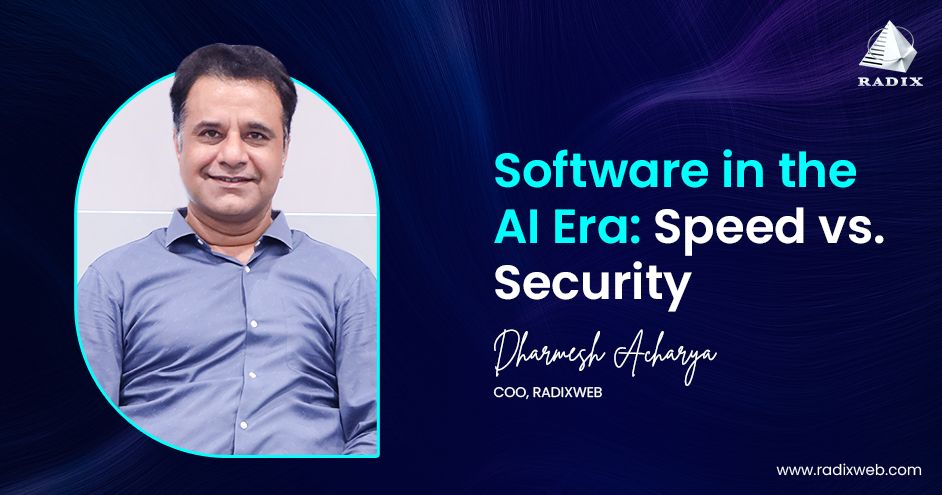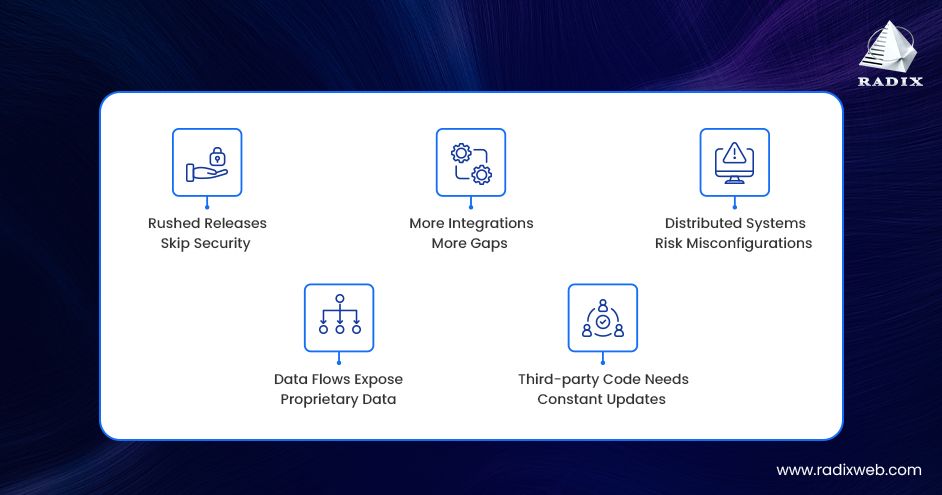Read More

Skip Setup Headaches and Start Your Project Fast - Download Free Boilerplates
Rearchitecting the New Era of Software Development - Speed vs Security in The Era of AI

Dharmesh Acharya

ON THIS PAGE
Security is no longer just a patch—it’s a mindset. Up until a few years back, security in coding and the development process meant running a scanner and leaving it to luck. Security was often a second priority – not planned but used as a patch.
However, in comparison to the 2000s, the software development landscape has vividly changed. With new tech innovations and AI-led automation, the threat landscape has evolved drastically. What previously used to be one of the items on our checklist has now become our foremost priority. In our journey to deliver tech-first innovation, we have adopted and integrated a security-first mindset and facilitated the same for our clients.
So, when I say Radixweb is a SOC Type 2, ISO 270001 and ISO 9001 certified software provider this is what I mean – the essential curve of our growth wasn’t marked by how many technologies we innovated with; but how better we handled the complexities that came with them.
Accelerated Development – Meeting Market Demands While Acknowledging the Risks
Software development in 2000s was a very different ballgame where custom capabilities and competent pricing could mark business distinction. However, with time, the era of accelerated development timelines arrived. To meet the market demand for quick deliveries, we tested the use of high impact coding assistants like GitHub Copilot.
These enhanced quick deliveries with fast prototyping, automating routine tasks, quality checks and promoted the emergence of cross-functional teams (where non-coders could leverage low-code and no-code to build apps). But such development efficiencies also brought with them a huge lot of complexities.
- Pressure to deliver faster meant traditional security reviews lagged behind
- Diverse tech integrations opened up vulnerabilities through several intersections
- Distributed systems meant more unauthorized access and misconfigurations
- Data flows between systems exposed proprietary data to breaches
- Third-party dependencies meant every package of libraries and frameworks we used had to be updated to prevent data breaches

The benefit of new-age development was that it democratized innovation. But the risk landscape was evolving at a double pace. This called for a reconsideration – not how we would look at security after a solution was built; but how we could pre-build and fit security into our workflows.
As cloud-led environments grew in demand and flow of data thrived between these distributed systems, we realized our systems would be vulnerable to sudden breaches and unauthorized access until we ensured software supply chain security.
Security-by-Design – Our Turning Point for Software and Product Engineering
While DevOps is an approach we started following even before the term was coined. Our transformation from a software vendor to an innovation partner was rightly facilitated by embracing DevSecOps.
For us, our work never ended at developing and deploying software. Since 2000, we always went the extra mile to ensure our tech partnerships delivered ‘value’ with the solution. ‘Engineering for Impact’ was always aimed at the realistic change our clients’ processes experienced because of our solutions – centred in both security and compliance with evolving industry regulations.
DevSecOps proved to be the appropriate route since we wanted to uphold our reputation of delivering flawless solutions to the market. Not just by enhancing and integrating efficiency in every step of the SDLC but also by securing every step of the way.
Aligning with agile principles, we embedded security in every step of the SDLC where our CI/CD pipelines included automated security scanning, ran dependency checks and validated with static code analysis.
Did it feel intrusive at first? It did! Because our developers were suited to remedying after code was entirely written. The new-age tools flagged code vulnerabilities in real-time. But what looked like a roadblock initially, gradually became an operational rhythm. With faster fixes and lesser bugs, we gradually saw the role of DevSecOps in enhancing developer confidence.
One of the reasons, why 97% clients stayed with us over five years, entrusted software maintenance and support to us and returned with new projects. Look at our Clutch and G2 reviews, closer to 98% CTOs have recommended us time and again for our solution security and responsiveness to market needs.
Enhancing Developer Experience and Weaving Security in Our Engineering DNA
Let’s accept the truth, even as frontliners of building a security landscape, you fall prey to the perks of automation. It’s a cliché addiction. With our adoption of fast and intuitive security tools, our developers experienced a boost in confidence; but it also let to their increased dependency on automated capabilities.
That’s where the process often clashed – developers demanding greater automation and security teams demanding wider visibility, control and oversight. This is the gap that DevSecOps bridged – by bringing in due governance.
We achieved this by balancing a human-machine workforce. Seamless security tools efficiently generated code ran security tests and enhanced deployment cycles. While human-led governance protocols ensured all security standards were met, blending security into the workflows frictionlessly.
Building with AI – Securing From AI
Building great software isn’t enough anymore! While businesses like us are relying on AI’s wonderful capabilities in designing and deploying software solutions and products with automation, some of us are walking the extra mile to secure our solutions with AI.
It’s hard to accept that across many enterprises, security flaws are still being shipped. And vulnerabilities live inside the applications – used frequently by our employees, partners and customers. These do not just open the door to data threats – they often go unnoticed before causing major havoc.
This is a gap we couldn’t ignore!
And this perhaps has been our most fruitful use of AI till date – securing systems with AI against its own vulnerabilities. From detecting log anomalies to predicting threats and identifying suspicious activities. We’ve transitioned AI to the role of a digital security analyst that works without rest!
But we didn’t leave it there! Working with AI also revealed that there could be cases where AI-written code could introduce exposures and that can get passed by the algorithm too!
This pushed us to have stronger human governance with timed code reviews and intuitive prompt engineering. Because working with AI doesn’t mean substituting human intelligence.
Leaning Towards Software Safety with Values of Collaboration and Co-creation
At Radixweb, ours is a process that embeds collaboration, foresight, care and empathy in the development process. It isn’t about always maintaining a shift—it’s all about building systems that are secure, resilient, scalable, trustworthy, predictable and drives favourable user experiences with AI.
To secure AI-driven development, we need:
- Early visibility into vulnerabilities
- Security that integrates directly into dev pipelines
- Less noise, more clarity in results
- And governance that doesn’t get in the way of innovation
Statistics say that by 2030, 95% of code will be AI-generated. We need to adapt – fast, so that safety and speed can move together at a pace.
Working closely with product teams, product managers and infrastructure engineers, we are committed to building systems that prioritize safety from the first line of code.
A couple of things that we prioritized at Radixweb:
- Starting small – integrating tools and practices gradually into the workflows rather than overhauling the entire security landscape overnight.
- Automating with caution – not relying on it blindly for crucial areas.
- Being in the learner’s mindset – continuing innovation while keeping ourselves updated about the growing security landscape.
- Involving security teams from scratch – shaping software architectures on the basis of their insights.
Decades of this sustainable practice has made us one of the most trusted names in the area of secured software development – one that delivers impact, drives true innovation with engineering excellence and helps businesses thrive in the era of disruptive changes and evolving threats.
So, as we celebrate our 25th year in the industry, I’m excited and cautious about what’s coming. But knowing that we have an immensely aligned team – I am confident that we are poised to take on any challenge that the market and technology throws at us – gracefully.
Ready to brush up on something new? We've got more to read right this way.


